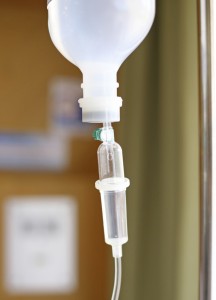 Up-front chemotherapy in prostate cancer is a controversial topic (as it should be, given the risks). The current paradigm is to treat patients with prostate cancer with hormonal therapy first, with radiotherapy added in appropriate cases, and then move on to chemotherapy only after the disease has become castration-resistant.
Up-front chemotherapy in prostate cancer is a controversial topic (as it should be, given the risks). The current paradigm is to treat patients with prostate cancer with hormonal therapy first, with radiotherapy added in appropriate cases, and then move on to chemotherapy only after the disease has become castration-resistant.
But chemotherapy is moving up the line, from the treatment of last resort, all the way to a front-line defense. Namely, a new study suggests it may have an even greater benefit in high-risk, localized prostate cancer.
For this study, 563 patients (with a mean age of 66) with high-risk localized prostate cancer were randomly assigned to receive one of these two types of therapy:
– standard therapy (24 months of androgen suppression and 8 weeks of external radiotherapy)
– standard therapy plus chemotherapy
After an average follow-up period of 6 years, the 4-year survival rate was higher (93 percent vs. 89 percent) in the chemotherapy group.
While this is definitely significant, it’s important to note that a lot of experts are still worried about the toxicity of chemotherapy. I’m one of those. So is Marc B. Garnick, MD, professor of medicine at Harvard Medical School in Boston, Massachusetts, editor-in chief of the Harvard Medical School Annual Report on Prostate Diseases. He has said: “With any adjuvant program comes the balance of risk of relapse vs. toxicity of the treatment program. These patients may have been cured with the standard therapy, yet may have been exposed to a fatal outcome in the adjuvant setting.” [Adjuvant therapy, by the way, simply means additional therapy.]
Garnick also noted, “While Sandler [referring to the above-mentioned study’s lead investigator, Howard M. Sandler, MD, of Cedars-Sinal Medical Center in Los Angeles] et al need to be congratulated for carrying out this complicated study, final assessment of its importance will by necessity require details, details, and more details, along with greater follow-up.”
I’m not here to tell you to opt for chemo or not. It is sometimes warranted, and sometimes not. The decision is personal, and it’s one you need to make with your doctor, and hopefully that’s a doctor that knows how to balance potential chemo benefit with toxicity risks. I just want to advise you to use caution when it comes to feeling pressured into chemo. Know the risks on both sides, and don’t make a snap decision.
I discussed the prostate in much greater detail in my article, “The great BPH scam,” in my Logical Health Alternatives newsletter from earlier this month. Subscribers can access this issue—and the complete archive—by visiting www.drpescatore.com and logging in to the Subscriber area of the website. (If you’re not already a subscriber, the website also has all the information you need to become one starting today.)
In this article, I talk a little more about enlarged prostate (clinically known as BPH, or benign prostatic hyperplasia (BPH), than primarily cancer per se, but remember that BPH symptoms are a lot like prostate cancer symptoms, and a man with BPH may have undetected prostate cancer. The article lists plenty of supplements for prostate health, as well as a resource for finding a doctor who will look at your complete prostate health, and will actually treat you based on a variety of individual factors, rather than opting for the one-size-fits-all approach that too many doctors lazily default to using.
Source:
American Society of Clinical Oncology (ASCO) 2015 Annual Meeting: Abstract LBA 5002. Presented May 31, 2015.
Upfront Chemo: New Caution or Option in Prostate Cancer? Medscape Medical News, May 31, 2015. http://www.medscape.com/viewarticle/845657

